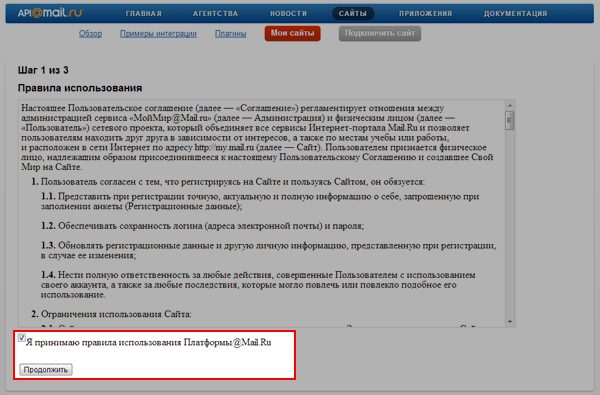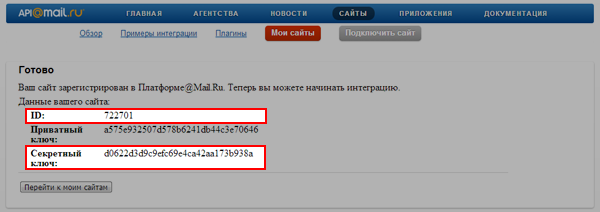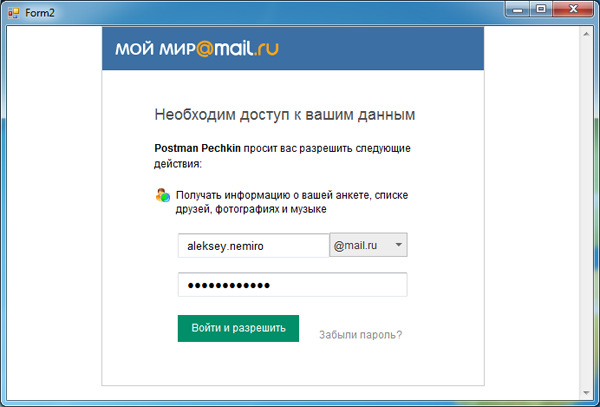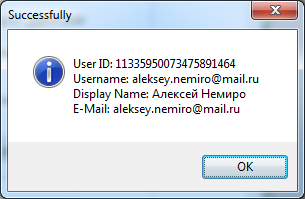Nemiro.OAuth OAuthBase
Nemiro.OAuth OAuth2Client
Nemiro.OAuth.Clients MailRuClient
Namespace: Nemiro.OAuth.Clients
Assembly: Nemiro.OAuth (in Nemiro.OAuth.dll) Version: 1.9.4.725 (1.9.4.725)
The MailRuClient type exposes the following members.
| Name | Description | |
|---|---|---|
| MailRuClient |
Initializes a new instance of the MailRuClient.
|
| Name | Description | |
|---|---|---|
| Clone |
Creates a shallow copy of the current object.
(Inherited from OAuthBase.) | |
| Clone(NameValueCollection, String) |
Creates a shallow copy of the current object.
(Inherited from OAuthBase.) | |
| Equals | (Inherited from Object.) | |
| Finalize | (Inherited from Object.) | |
| GetAccessToken |
Gets the access token from the remote server.
(Inherited from OAuth2Client.) | |
| GetHashCode | (Inherited from Object.) | |
| GetSpecifiedTokenOrCurrent |
Returns the specified access token or the current access token.
(Inherited from OAuthBase.) | |
| GetType | (Inherited from Object.) | |
| GetUserInfo | Obsolete.
Gets the user details via API of the provider.
(Inherited from OAuthBase.) | |
| GetUserInfo(AccessToken) |
Gets the user details.
(Overrides OAuthBase GetUserInfo(AccessToken).) | |
| MemberwiseClone | (Inherited from Object.) | |
| RedirectToAuthorization |
Redirects a client to the Authorization URL.
(Inherited from OAuthBase.) | |
| RefreshToken |
Sends a request to refresh the access token.
(Overrides OAuth2Client RefreshToken(AccessToken).) | |
| RevokeToken |
Sends a request to revoke the access token.
(Inherited from OAuthBase.) | |
| ToString | (Inherited from Object.) |
| Name | Description | |
|---|---|---|
| AccessToken |
Gets or sets an access token.
(Inherited from OAuthBase.) | |
| AccessTokenUrl |
Gets or sets the address for the access token.
(Inherited from OAuthBase.) | |
| AccessTokenValue |
Gets an access token value.
(Inherited from OAuthBase.) | |
| ApplicationId |
Gets or sets the application identifier.
(Inherited from OAuthBase.) | |
| ApplicationSecret |
Gets or sets the application secret key.
(Inherited from OAuthBase.) | |
| AuthorizationCode |
Gets or sets access code for access token requests.
(Inherited from OAuthBase.) | |
| AuthorizationUrl |
Gets the endpoint of the authorization.
(Inherited from OAuth2Client.) | |
| AuthorizeUrl |
Gets or sets the base address for login.
(Inherited from OAuthBase.) | |
| DefaultScope |
The deault scope.
(Inherited from OAuth2Client.) | |
| GrantType |
Gets or sets grant type.
(Inherited from OAuth2Client.) | |
| Parameters |
Gets or sets additional query parameters.
(Inherited from OAuthBase.) | |
| Password |
Gets or sets password if GrantType is password or client_credentials.
(Inherited from OAuth2Client.) | |
| ProviderName |
Unique provider name: Mail.Ru.
(Overrides OAuthBase ProviderName.) | |
| ReturnUrl |
Return URL.
(Overrides OAuthBase ReturnUrl.) | |
| Scope |
The scope of the access request.
(Inherited from OAuth2Client.) | |
| ScopeSeparator |
The separator in the scope list.
(Inherited from OAuth2Client.) | |
| State |
Gets or sets unique request identifier.
For clients the value sets is automatically.
(Inherited from OAuthBase.) | |
| SupportRefreshToken |
Gets or sets a value indicating whether the current client supports refreshing access token.
(Inherited from OAuthBase.) | |
| SupportRevokeToken |
Gets or sets a value indicating whether the current client supports revoking access token.
(Inherited from OAuthBase.) | |
| Username |
Gets or sets username if GrantType is password or client_credentials.
(Inherited from OAuth2Client.) | |
| Version |
Gets the version of the OAuth protocol.
(Inherited from OAuthBase.) |
Mail.Ru is a popular email service, search engine, social network, photo & video hosting, blogs and another services in Russia and CIS.
Register and Configure a Mail.Ru Site
 | Web Management Interface may change over time. Applications registration shown below may differ. If the interface is changed, you need to register the application and get Client ID and Client Secret. For web projects, configure return URLs. If you have any problems with this, please visit issues. If you do not find a solution to your problem, you can create a new question. |
Unfortunately, the interface is only in Russian.
You must have a confirmed account in Mail.Ru.
Open Sites page and click Connect a New Site.

Accept the terms of the agreement.

Enter the site name, URL and click the Next button.

Download the receiver.html file and place it in the root directory of your site.
This step can be skipped (Пропустить).

The last step you will find the Client ID and Client Secret.
Use this for creating an instance of the MailRuClient.

OAuthManager.RegisterClient ( new MailRuClient ( "722701", "d0622d3d9c9efc69e4ca42aa173b938a" ) );
For more details, please visit to the Mail.Ru API Documentation.
Windows Forms
The following example shows how to use the MailRuClient in desktop applications.
To test the example, create a new Windows Forms project with two forms. Add a Button to the Form1.
public Form1() { InitializeComponent(); button1.Click += new EventHandler(button1_Click); } private void Form1_Load(object sender, EventArgs e) { // mail.ru client registration OAuthManager.RegisterClient ( new MailRuClient ( "722701", "d0622d3d9c9efc69e4ca42aa173b938a" ) ); } private void button1_Click(object sender, EventArgs e) { var frm = new Form2(); frm.ShowDialog(); }
Add a WebBrowser to the Form2.
public Form2() { InitializeComponent(); webBrowser1.DocumentCompleted += new System.Windows.Forms.WebBrowserDocumentCompletedEventHandler(webBrowser1_DocumentCompleted); webBrowser1.Navigate(OAuthWeb.GetAuthorizationUrl("Mail.Ru")); } private void webBrowser1_DocumentCompleted(object sender, WebBrowserDocumentCompletedEventArgs e) { // waiting for results if (e.Url.Query.IndexOf("code=") != -1 || e.Url.Fragment.IndexOf("code=") != -1 || e.Url.Query.IndexOf("oauth_verifier=") != -1) { // is the result, verify var result = OAuthWeb.VerifyAuthorization(e.Url.ToString()); if (result.IsSuccessfully) { // show user info MessageBox.Show ( String.Format ( "User ID: {0}\r\nUsername: {1}\r\nDisplay Name: {2}\r\nE-Mail: {3}", result.UserInfo.UserId, result.UserInfo.UserName, result.UserInfo.DisplayName ?? result.UserInfo.FullName, result.UserInfo.Email ), "Successfully", MessageBoxButtons.OK, MessageBoxIcon.Information ); } else { // show error message MessageBox.Show(result.ErrorInfo.Message, "Error", MessageBoxButtons.OK, MessageBoxIcon.Error); } this.Close(); } }
Result of the program is shown in the images below.


ASP .NET MVC
The following example shows how to use the MailRuClient in ASP .NET MVC Application.
In the Application_Start event handler (Global.asax file) is registered the MailRuClient.
protected void Application_Start() { OAuthManager.RegisterClient ( new MailRuClient ( "722701", "d0622d3d9c9efc69e4ca42aa173b938a" ) ); }
The MailRuLoginResult method will handle authorization result.
public ActionResult MailRuLoginResult() { var result = OAuthWeb.VerifyAuthorization(); if (result.IsSuccessfully) { var user = result.UserInfo; // NOTE: For StringBuilder import the System.Text StringBuilder r = new StringBuilder(); r.AppendFormat("User ID: {0}\r\n", user.UserId); r.AppendFormat("Name: {0}\r\n", user.DisplayName); r.AppendFormat("Email: {0}", user.Email); return new ContentResult { Content = r.ToString(), ContentType = "text/plain" }; } return new ContentResult { Content = "Error: " + result.ErrorInfo.Message, ContentType = "text/plain" }; }
Add action method for redirection to the Mail.Ru.
public ActionResult MailRuLogin() { string authUrl = OAuthWeb.GetAuthorizationUrl("Mail.Ru", Url.Action("MailRuLoginResult", "Home", null, null, Request.Url.Host)); return Redirect(authUrl); }
On a page add link to the MailRuLogin method.
@Html.ActionLink("Log in with Mail.Ru", "MailRuLogin")NOTE: For proper processing, you will need to download and put on your site a receiver.html file.